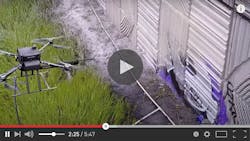Graffiti-fighting drone is making maintenance workers’ jobs easier and safer
Drones have limitless potential across a variety of industries. Whether they’re being used to fight fires, aid in search and rescue missions, capture aerial images for agriculture, real estate, or construction, or even delivering packages to customers, drones are changing the way workers around the world do their jobs. One ingenious maintenance worker in Washington is even using drones to combat the state’s growing graffiti problem.
Last year, the state spent $815,000 in time and equipment on graffiti removal. The Washington State Department of Transportation (WSDOT), which removes graffiti from walls, signs, bridges, and overpasses, spent nearly 10,300 hours in 2023 covering 700,00 square feet of graffiti. This is not just a time or money issue, however. Graffiti in difficult locations can put maintenance workers at risk of high fall hazards and other injuries.
According to April Leigh and Tina Werner in a recent WSDOT blog post, Mike Gauger, a WSDOT maintenance superintendent, came up with the idea after working with the Tacoma Narrows Bridge team, which used drones for bridge inspections. Because of these drones, inspections could be done easily and safely with fewer workers. Gauger wondered if a similar setup could be used to cover graffiti in hard-to-reach spots. Gauger then presented his idea to the maintenance director, and a pilot program was established to test the idea.
In an excerpt from the blog post, the authors write: “Mike researched the use of drones with several manufacturers who produced similar products, and learned that there were no drones being designed to do things like this. He reached out to some drone manufacturers and found one that was willing to collaborate on the design of a prototype system. The team worked together on the design for months. Their first attempt malfunctioned in early testing, which gave them the information they needed to make adjustments. A final working prototype was delivered in spring of 2024.”
Here’s how it works. Using a Aquiline Endure model drone, an operator located on the ground can maneuver and position the drone. A hose is used to supply paint on the ground to the airborne drone.
In a recent quote, Gauger spoke about how this innovative program came to be. "To mitigate graffiti in those hard-to-reach places, we very often have to use extreme fall protection. Sometimes we use ladders, sometimes we use bucket trucks, and we also very commonly use million-dollar bridge inspection trucks. Anytime we use fall protection, we consider it a hazardous operation. Our people are well trained and have the best equipment to do so, but there's an element of risk in doing it that way. Besides my maintenance superintendent duties, I'm also the director of the Olympic region drone program. I have several drones as well as pilots scattered around our region. We use them for lots of different maintenance activities. We use them for bridge inspection very commonly. We also use them for emergency response, slides, sink holes, that sort of thing. This made me start thinking about alternate ways of delivering paint to the graffiti. I came to the conclusion that if we could use a drone, make it spray paint good enough to cover graffiti, this might be a better way to mitigate the dangers of graffiti mitigation.”
Gauger continues, “In addition to reducing the risk to our employees while performing this work, using this drone also allows us to get to these hard-to-reach areas more frequently. By getting to them more frequently, the traveling public is happier they don't have to see it as often. Furthermore, it allows us to get to many of these hard-to-reach areas with far less impact on traffic, sometimes with no traffic control, sometimes with minimum traffic control. Also, the efficiencies of using the drone allow us to cover large areas in a very short period of time, ultimately allowing us to get more done and be more efficient.”
About the Author
Alexis Gajewski
Senior Content Strategist
Alexis Gajewski has over 15 years of experience in the maintenance, reliability, operations, and manufacturing space. She joined Plant Services in 2008 and works to bring readers the news, insight, and information they need to make the right decisions for their plants. Alexis also authors “The Lighter Side of Manufacturing,” a blog that highlights the fun and innovative advances in the industrial sector.
